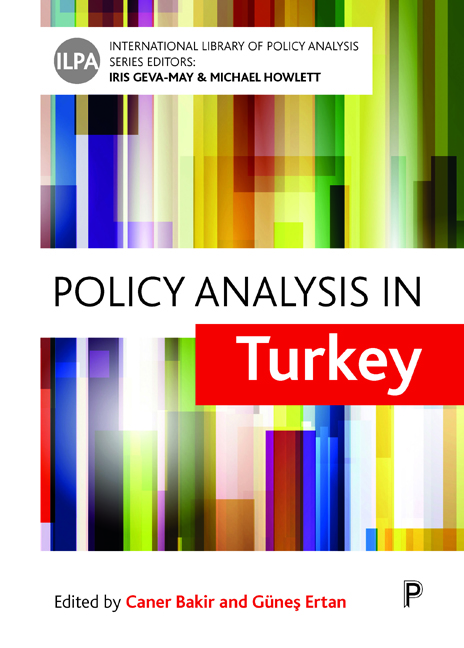Book contents
- Frontmatter
- Contents
- List of tables and figures
- Notes on contributors
- Editors’ introduction to the series
- one Pushing the pendulum from politics to policy: the state of policy analysis in Turkey
- Part One Historical roots, styles and methods of policy analysis in Turkey
- Part Two Policy analysis by governments
- Part Three Experts, international actors and public opinion
- Part Four Parties and civil society-based policy analysis
- Part Five Academic, bureaucratic and advocacy-based policy analysis
- Index
thirteen - Policy analysis and capacity in the Central Bank of Turkey
Published online by Cambridge University Press: 19 April 2022
- Frontmatter
- Contents
- List of tables and figures
- Notes on contributors
- Editors’ introduction to the series
- one Pushing the pendulum from politics to policy: the state of policy analysis in Turkey
- Part One Historical roots, styles and methods of policy analysis in Turkey
- Part Two Policy analysis by governments
- Part Three Experts, international actors and public opinion
- Part Four Parties and civil society-based policy analysis
- Part Five Academic, bureaucratic and advocacy-based policy analysis
- Index
Summary
Introduction
Central banks are at the centre of macroeconomic policy-making. This is because, within the state apparatus, they design and implement monetary policy and advice governments. Following the global financial crisis (GFC), central banks and bank regulators embraced a macroprudential approach as a new conventional wisdom aiming to limit and contain systemic financial risk through macroprudential regulation (Baker, 2013). The Central Bank of the Republic of Turkey (hereafter CBRT) is no exception (Kara, 2016).
The GFC, as a structural ideational context, opened a window of opportunity for a change in the prevailing central banking assumptions at national and international levels that price stability is not sufficient to ensure financial stability. Unsurprisingly, macroprudential regulation that aimed at financial stability emerged as one of the top policy issues among central banks worldwide (Goodhart, 2011; Baker, 2013).
In the post-GFC structural material context, the quantitative easing and low interest rate policies adopted by major central banks in developed economies accelerated capital inflows to emerging and developing countries. Turkey already had first-hand experience with the adverse effects of such capital flows in the past leading to economic and financial crises. This included appreciation of the Turkish lira due to the short-term, speculative and unproductive nature of those inflows, along with increasing financialisation in the economy with excess bank credit growth and high leverage (Bakır and Öniş, 2010). The result has been the widening current account deficit that increased the macroeconomic vulnerability to capital flows, signalling a risk of financial/economic crisis. Similar factors had resulted in the 1994 and 2001 Turkish financial crises, which were triggered by sudden stops of capital inflows followed by capital outflows.
In this environment, central banks in developing countries including Turkey used various monetary (for example, interest rate corridor) and macroprudential policy tools (for example, required reserves ratio) to limit and contain macroeconomic and financial stability risks arising in a surge in capital flows (IMF, 2011; Lim et al, 2011). Specifically, the leadership at the CBRT proactively engaged in policy design aimed at ensuring financial and macroeconomic stability triggered by policy instruments (for a discussion based on causal mechanisms, see Akgunay and Bakır, 2016). It experimented with what Hakan Kara, Chief Economist of CBRT, called a ‘new policy mix’, or ‘an unconventional approach in monetary policy’ in November 2010 (see Kara, 2012, p 2).
- Type
- Chapter
- Information
- Policy Analysis in Turkey , pp. 215 - 234Publisher: Bristol University PressPrint publication year: 2018



